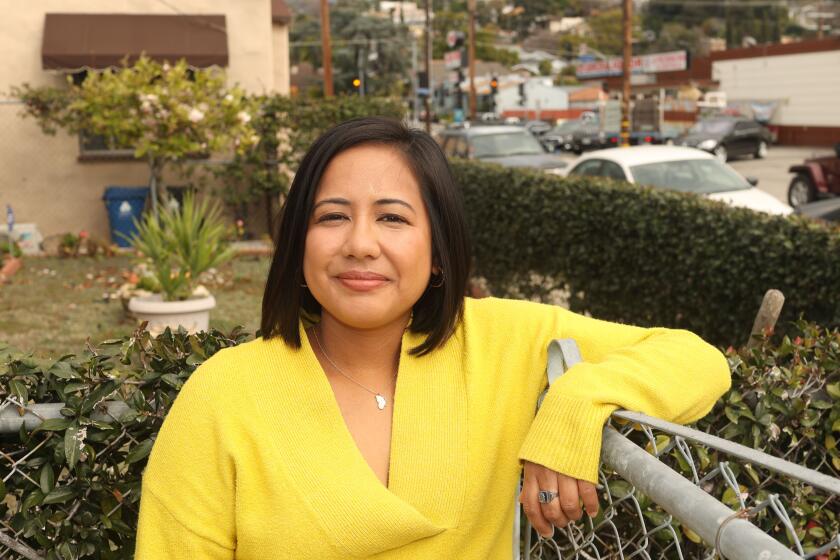Determined Youth Leads Students to Test Ocean Water for Pollution
- Share via
Disturbed by the ocean pollution in her own backyard, Margaux Thomas set up a makeshift laboratory in the family garage to test the water herself, curious about just how safe it was to wade into the surf.
At the time, the Laguna Beach High School senior never imagined the impact those amateur experiments would have on her peers--and public awareness about the environment.
Now, as the proud founder of the first high school branch of the Surfrider Foundation, she and fellow students test bacteria levels at 40 city beaches on a weekly basis, and keep everyone informed by posting the results in shops and restaurants.
“What she has started really has legs,” said Marc Wright, chairman of the Laguna chapter of the foundation, an international environmental group.
For Thomas, who had had designs on becoming an aerospace engineer since she was a little girl, the crusade has become so consuming and fulfilling that she now plans to major in environmental policy in college next year.
“I want to keep the water clean. I’m fascinated by it,” she said in her parents’ oceanfront home. “I feel like I really have increased public awareness. People come up to me and say it’s great what I am doing. Everyone’s very supportive.”
Thomas, 17, became obsessed with water pollution shortly after her parents moved the family from their leafy hilltop neighborhood in Laguna Beach to the sandy shores of Thousand Steps beach, and she went skimboarding.
It was July 4, 2000, and she was approached by a lifeguard who pointed out a stake near the surf zone and warned her to stay on one side of it, because the water on the other side was too dirty to swim in.
“He informed me that the right side was safe and the left side was contaminated,” Thomas recalled. “I thought, ‘How could that be? What is going on?’ Since then, it has always been in the back of my mind.”
Thomas started asking questions and doing her own research to find out how regularly the water was being monitored and what bacteria levels were considered harmful.
She didn’t realize she could take the initiative herself until Chad Nelson, a local Surfrider member, gave a presentation to her biology class early this year. He agreed to set her up with all the equipment she needed to test for the enterococcus bacteria. Mory Granger, a UC Irvine microbiologist, later approved of Thomas’ methodology.
So from June to September, Thomas worked on her own, traipsing regularly to eight beaches to collect samples, creating a Web site to post her results.
After a while, she decided that the computer site wasn’t reaching enough people. So Thomas decided to step up her public awareness campaign by making fliers, hanging them up near beaches and asking shop owners to post them as well.
“I would see parents checking signs, and not letting their kids [go in the water] if they thought the levels were too high,” she said. “I really felt like I was making a difference.”
Thomas began recruiting fellow students to join her, and in mid-October she moved her laboratory to the school.
Now, each Wednesday before the first bell rings, members of the high school’s Surfrider club--many of them skimboarders or surfers--carry plastic bags to 40 spots along Laguna’s 7-mile coastline to collect samples. They store the bags in a refrigerator at the lab, where they meet again at lunchtime to start the tests, which take 24 hours.
Fliers titled “How clean is the water?” are replaced each week on bulletin boards near the high school and at stores and restaurants throughout town. Thomas, who keeps a binder of all the results, is happy to report that for the most part, the water has been “pretty clean.” But the pollution readings spike after it rains.
“Pretty much every beach exceeds the legal level,” she said.
Students get community service credit for their work. And they gain insights into the causes and consequences of ocean pollution.
“It’s something that is literally right out their front door,” said Wright of Surfrider. “It’s not esoteric. It’s hands-on. They’re all in the water and at the beach constantly. Most can see it from their house or from somewhere on the street. The community relies on the ocean for attracting tourism, for their own recreation. It’s really an issue of civic involvement.”
Surfrider has provided about $10,000 so far. Members also lend technical advice and help the lab pursue state certification, hoping one day that the students’ work can be used as official pollution data.
The ultimate goal is to persuade other school districts to follow Laguna’s lead.
“I’d love to set an example,” said Sunny Taylor, education chairwoman for the Laguna chapter of Surfrider. “We want to raise awareness and branch out to other communities.”
Thomas’ father, a tax manager, and mother, a manager at the Fashion Island shopping center in Newport Beach, are proud of their daughter but take no credit, noting that their eldest child--also a varsity soccer player--has always been energetic and goal-oriented.
“She’s incredibly hard-working and self-motivated,” said her dad, Mark Thomas. “It’s something she picked up all by herself.”
More to Read
Sign up for Essential California
The most important California stories and recommendations in your inbox every morning.
You may occasionally receive promotional content from the Los Angeles Times.













